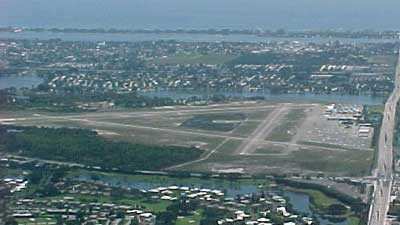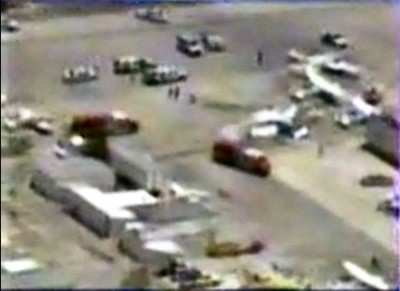Sad Accident Does Not Appear To Have Been Caused By Fuel
Exhaustion
 The horrific crash that claimed the
lives of a pilot and passenger just seconds after takeoff from
Florida's Lantana Airport, appears to have occurred just 2 and a
half hours (tach time) after extensive engine repairs were
undertaken... but nearly six months (calendar) before. An annual
inspection had been completed on April 1st, and witnesses report
that the aircraft had flown the week before.
The horrific crash that claimed the
lives of a pilot and passenger just seconds after takeoff from
Florida's Lantana Airport, appears to have occurred just 2 and a
half hours (tach time) after extensive engine repairs were
undertaken... but nearly six months (calendar) before. An annual
inspection had been completed on April 1st, and witnesses report
that the aircraft had flown the week before.
The bright red Bonanza V35 was only airborne a short while
(estimated by one witness as all of 30 seconds), when it reportedly
encountered engine problems (possibly a total power failure) and
then attempted to make it back to the airport. In the process of
trying to make the runway, the aircraft collided with at least
aircraft on the ground, a Cessna 337, severing most of he left
wing, and then collided with a trailer on site.
NTSB Identification: ERA09FA283
14 CFR Part 91: General Aviation
Accident occurred Wednesday, May 06, 2009 in Lantana, FL
Aircraft: BEECH K35, registration: N111YR
Injuries: 2 Fatal.
This is preliminary information, subject to change, and may
contain errors. Any errors in this report will be corrected when
the final report has been completed.
On May 6, 2009, about 1130 eastern daylight time, a Beech K35,
N111YR, was substantially damaged during a forced landing, after it
experienced a loss of engine power during the initial climb from
the Palm Beach County Airport (LNA), Lantana, Florida. The
certificated commercial pilot and the passenger/owner of the
airplane were killed. Visual meteorological conditions prevailed
and no flight plan had been filed for the local flight. The
personal flight was conducted under the provisions of Title 14 Code
of Federal Regulations Part 91.

According to witnesses at LNA, the airplane was based at the
airport. The airplane departed from runway 15, a 3,421-foot-long,
asphalt runway. The airplane reached an altitude of 75 to 100 feet
above the ground, when the engine "sputtered" or "coughed" and then
"quit." The airplane entered a right descending turn back toward
the airport with the landing gear in the extended position and the
propeller "wind-milling." The airplane struck two parked,
unoccupied airplanes, before impacting the ground, and colliding
with a tractor-trailer container.
The airplane came to rest on a heading about 360 degrees, about
100 feet from the initial contact with the parked airplanes, and
about 80 feet from the initial ground contact. The ground scar was
oriented on approximately a 280-degree heading. All major
components of the airplane were located at the accident site. The
aft 11 feet of the airplane structure was separated and remained
attached via cables. The remainder of the airframe was located
underneath the trailer. The engine separated at the firewall and
was located about 75 feet, on a 300-degree heading from the main
wreckage. The engine throttle, propeller and mixture controls in
the cockpit were observed in the full-forward position. The right
wing tip and a majority of the right aileron were separated from
the right wing. The inboard 12 inches of the right aileron remained
attached. The right flap was observed in the retracted position,
and contained crushing damage to its spar. The left wing remained
attached; however, the majority of the structure inboard of the
aileron, aft of the main spar was compromised.
The airplane was equipped with a "v-tail" configuration which
utilized an elevator-rudder combination (ruddervator) flight
control. The right side of the empennage was intact, the left side
exhibited significant impact damage. The left ruddervator bellcrank
assembly was fractured. Flight control continuity was confirmed
from the left ruddervator control to the bellcrank, and from the
bellcrank to the forward cockpit area. Flight control continuity
was also confirmed from the right ruddervator control to the
forward cockpit area and from both ailerons to the control
yoke.

The airplane was equipped with a "throw-over" control yoke,
which was found locked, in the left pilot position.
The propeller remained attached to the engine. One blade was
straight and exhibited minor damage. The other blade was bent about
mid-span and contained scratches consistent with it sliding along
the ground.
Initial examination of the engine did not reveal any
catastrophic engine malfunctions. The fuel pump, fuel servo and
both magnetos remained attached to the engine. The engine was
rotated by hand using the propeller. Rocker arm movement was
observed and thumb compression was attained on all cylinders. In
addition, spark was observed on all magneto leads. The top spark
plugs were removed. Their electrodes were intact and exhibited gray
deposits. The fuel manifold contained fuel and was absent of
contamination. A lighted borescope examination of all cylinders did
not reveal any preimpact malfunctions. The engine was retained for
further examination.

The airplane was equipped with an interconnected main and
auxiliary fuel tank in each wing. The fuel selector in the cockpit
was observed in the left main fuel tank position. Prior to the
flight, the airplane's main fuel tanks were "topped-off" with 12.7
gallons of 100 low-lead aviation gasoline. The left wing fuel tanks
were compromised during the accident; however, a fuel sample was
obtained from the left inboard fuel drain and it was absent of
visible contamination. Both fuel tanks on the right wing were
intact and fuel was visible at the top of their respective
refueling ports. Fuel samples taken from the right wing fuel tanks
were also absent of contamination.
Preliminary review of maintenance records revealed that at the
time of the accident, the airplane had been operated for about 2.5
hours since the engine was disassembled for "extensive engine
repair" on December 5, 2008. The airplane's most recent annual
inspection was performed on April 1, 2009. Witnesses reported that
they believed the airplane was flown sometime during the week prior
to the accident.

The pilot reported 2,458 hours of total flight experience on his
most recent application for a Federal Aviation Administration (FAA)
second-class medical certificate, which was dated on day of the
accident.
The owner/passenger held a private pilot certificate. He
reported 2,268 hours of total flight experience on his most recent
application for an FAA third-class medical certificate, which was
issued on July 26, 2005.
A weather observation taken at 1134, at the Palm Beach
International Airport (PBI), located about 5 miles north of the
accident site, reported, wind from 120 degrees at 13 knots;
visibility 10 statute miles; scattered clouds at 3,200 feet,
temperature 28 degrees Celsius (C), dew point 19 degrees C;
altimeter 30.08 inches of mercury.
 SpaceX to Launch Inversion RAY Reentry Vehicle in Fall
SpaceX to Launch Inversion RAY Reentry Vehicle in Fall Aero-News: Quote of the Day (04.23.24)
Aero-News: Quote of the Day (04.23.24) Aero-News: Quote of the Day (04.20.24)
Aero-News: Quote of the Day (04.20.24) ANN's Daily Aero-Linx (04.20.24)
ANN's Daily Aero-Linx (04.20.24) Aero-News: Quote of the Day (04.21.24)
Aero-News: Quote of the Day (04.21.24)







